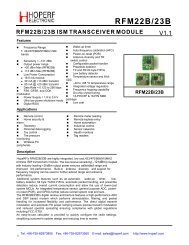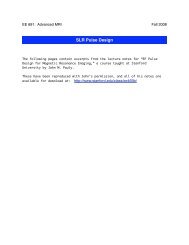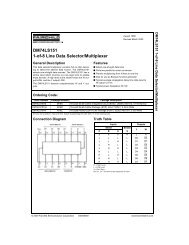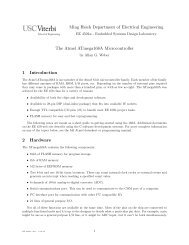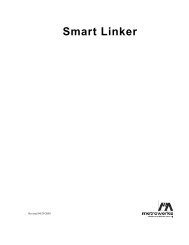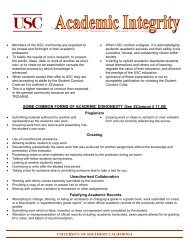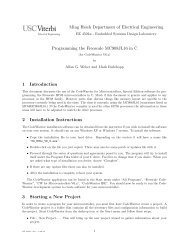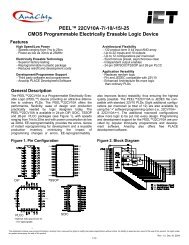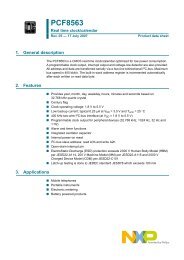EE 591 K. Nayak MR Imaging and Reconstruction Homework #4 ...
EE 591 K. Nayak MR Imaging and Reconstruction Homework #4 ...
EE 591 K. Nayak MR Imaging and Reconstruction Homework #4 ...
You also want an ePaper? Increase the reach of your titles
YUMPU automatically turns print PDFs into web optimized ePapers that Google loves.
<strong>EE</strong> <strong>591</strong> K. <strong>Nayak</strong><br />
<strong>MR</strong> <strong>Imaging</strong> <strong>and</strong> <strong>Reconstruction</strong><br />
<strong>Homework</strong> <strong>#4</strong><br />
Due: Monday, January 27th (in class)<br />
• This homework assignment depends heavily on Matlab. You will write simple image<br />
reconstruction scripts <strong>and</strong> a simple Bloch simulator, <strong>and</strong> then simulate excitation<br />
pulses as well as some off-resonance artifacts.<br />
• You may work on the homework in groups, but must each submit independently <strong>and</strong><br />
provide your own explanations of the images. If you are not an experienced Matlab<br />
user, please work with someone who is.<br />
1. Cartesian Image <strong>Reconstruction</strong><br />
Image reconstruction from cartesian k-space samples (as in 2DFT) primarily depends<br />
on an FFT.<br />
Generally in <strong>MR</strong> image reconstruction, the origin for both k-space data <strong>and</strong> the<br />
reconstructed image is at the center of the image or data array. However, the FFT<br />
operates using a convention where the origin is at the beginning of the array, or at<br />
the corner of the 2D array. To do a centered FFT or inverse FFT, we use functions<br />
like the following, which incorporate an fftshift().<br />
% function im = ift(dat)<br />
%<br />
% Function does a centered inverse 2DFT of the data:<br />
function im = ift(dat)<br />
im = fftshift(ifft2(fftshift(dat)));<br />
Load the head dataset headraw.mat <strong>and</strong> reconstruct the head image:<br />
> load headraw.mat<br />
> im = ift(headraw);<br />
> dispimage(abs(im));<br />
Submit code, images, <strong>and</strong> answers for the following questions:<br />
1
(a) Upsample the original raw data matrix to 512x512 by inserting lines of zeros<br />
in between the data samples (in both directions). What happens to the reconstructed<br />
image? Anything useful?<br />
(b) Zero-pad the original raw data matrix up to 512x512 <strong>and</strong> reconstruct. What<br />
happens to the reconstructed image? Anything useful?<br />
2. Test Objects<br />
When simulating sequences it’s often useful to fabricate data for hypothetical objects.<br />
An easy way to do this is to design a test object that is made up of shapes with<br />
continuous Fourier transforms that are easy to describe analytically.<br />
For example, a circular object rect(r) would have a continuous fourier transform<br />
that is jinc(kr), <strong>and</strong> rect(x)rect(y) has a continuous fourier transform that is<br />
sinc(kx)sinc(ky).<br />
Use the following comm<strong>and</strong>s to generate one possible test object:<br />
> krange = (-128:127)/256;<br />
> [ky kx] = meshgrid(krange,krange);<br />
> kr = sqrt(kx.^2 + ky.^2);<br />
> tx_circ = 25*25*jinc(25*kr); % FTx of circle with diameter 25<br />
> tx_rect = 5*30*sinc(5*kx).*sinc(30*ky); % FTx of rectangle 5x30<br />
> tx = tx_circ .* exp(-j*2*pi*kx*30) ...<br />
> + tx_rect .* exp(-j*2*pi*(-10*kx + 20*ky));<br />
> im = ift(tx);<br />
> figure;<br />
> dispimage(abs(tx));<br />
> figure;<br />
> dispimage(abs(im));<br />
(a) Examine the reconstructed object carefully (zoom into different areas, <strong>and</strong> window<br />
the image). Describe artifacts that you find, <strong>and</strong> why they are there.<br />
(b) Generate a raw data matrix for your own test object. You may use the provided<br />
rectangle fourier() <strong>and</strong> ellipse fourier() functions. Be creative,<br />
<strong>and</strong> make sure the test objects use up a large portion of the field of view, <strong>and</strong><br />
that they contain some elements that have high spatial resolution.<br />
(c) When we simulate an object containing different tissues, it is beneficial to create<br />
raw data matrices for each tissue type. For example:<br />
> tx_water = 100*100*jinc(100*kr) - 50*50*jinc(50*kr);<br />
> tx_fat = 1.2 * (50*50*jinc(50*kr));<br />
> tx = tx_water + tx_fat;<br />
> im = ift(tx);<br />
> dispimage(abs(im));<br />
2
This test image is a circle of fat surrounded by a circle of water. Note that we<br />
made fat 20% brighter than the water.<br />
With separated raw-data for the fat <strong>and</strong> water, it’s easier to simulate the effects<br />
of off-resonance (or other tissue differences). In 2DFT imaging, the signal phase<br />
due to off-resonance can be expressed as a function of kx. Suppose that the slice<br />
is excited at t = 0, <strong>and</strong> readouts occur from t = 10 to 30 ms. Express t as a<br />
function of kx (Note that the kx matrix values go from -0.5 to 0.5). Suppose<br />
we are imaging at 3 Tesla so that ∆f = -440 Hz for fat. Apply the appropriate<br />
phase to the fat raw data, <strong>and</strong> reconstruct the fat <strong>and</strong> water image. What do<br />
you see?<br />
You just reconstructed the image for a 20 ms readout with a 20 ms TE. Repeat<br />
the reconstruction for a 22 ms TE, 24 ms TE, <strong>and</strong> 28 ms TE. Do you notice any<br />
changes in the region of overlap? What is happening? Hint: look at the image<br />
phase dispimage(angle(im)).<br />
Now reconstruct the image for a 8 ms readout with a 20 ms TE. What do you<br />
see?<br />
(d) In PR <strong>and</strong> spiral imaging, the time map is a function primarily of kr. Suppose<br />
that we are using single-sided PR sequence with readouts again occur from<br />
t = 10 to 30 ms (this time TE = 10 ms). If t is a linear function of kr, reconstruct<br />
the resulting image. Remember to zero-out portions of the raw data matrix<br />
which are outside the circular region that is acquired (i.e. where kr > 0.5).<br />
Repeat the reconstructions if the readouts are shortened to 10 ms? <strong>and</strong> again<br />
shortened to 4 ms? (always starting 10 ms after the excitation)<br />
Explain your findings.<br />
3. Bloch Simulation<br />
In this problem you will implement a Bloch equation simulator, <strong>and</strong> use it to test the<br />
performance of excitation pulses.<br />
In the presence of RF pulses, Gradient fields, <strong>and</strong> relaxation, the Bloch equation<br />
dictates the behavior of spin magnetization. In the rotating frame, the magnetization<br />
vector experiences excitation, precession, <strong>and</strong> relaxation. In reality these three things<br />
are happening simultaneously, but a good approximation is to look at short time<br />
intervals (dt) <strong>and</strong> simulate the effects of the three separately.<br />
If including relaxation, off-resonance, precession due to gradients, <strong>and</strong> excitation, you<br />
might use code similar to the following:<br />
> Mo = 1;<br />
> M = [0;0;Mo]; % equilibrium magnetization<br />
...<br />
> E1 = exp(-dt/T1);<br />
> E2 = exp(-dt/T2);<br />
> A = [E2 0 0; 0 E2 0; 0 0 E1];<br />
> b = [0;0;(1-E1)];<br />
3
...<br />
> M = xrot(gamma*B1*dt) *M; % excitation_x: rotation about the x axis<br />
> M = zrot(2*pi*df*dt) *M; % precession due to off-resonance (df)<br />
> M = zrot(gamma*(Gx*x+Gy*y+Gz*z)*dt) *M;<br />
% precession due to Gradients<br />
> M = A*M+b*Mo; % relaxation<br />
In this problem, you will be simulating excitation pulses, off-resonance, <strong>and</strong> gradients.<br />
Relaxation is ignored.<br />
Browse the provided simpulse.m file <strong>and</strong> verify that it simulates the rotations experienced<br />
by a spin at position z due to a given b1 (RF pulse in Gauss), gz (Z gradient<br />
in Gauss/cm), <strong>and</strong> df (off-resonant frequency in Hz).<br />
For the following two parts assume that magnetization begins at equilibrium, that<br />
Mo = 1, <strong>and</strong> ignore relaxation. The waveforms you will load have a sampling rate of<br />
4µs. And gamma is 26752 rad/s/G.<br />
(a) Load the slice selective RF pulse sliceselect.mat which contains an RF pulse<br />
<strong>and</strong> associated Z-gradient. Simulate the excitation profile for spins with zpositions<br />
from -1 cm to 1 cm in 0.2 mm (or smaller) increments. Plot Mx,<br />
My, <strong>and</strong> Mz as a function of z position.<br />
Repeat the simulation assuming off-resonance with ∆f = -440 Hz (fat). What<br />
happens to the slice profile? What are the implications if we use this excitation<br />
pulse to image a slice in the body that contains both water <strong>and</strong> fat?<br />
(b) Load the spectral-spatial RF pulse specspat.mat which also contains an RF<br />
pulse <strong>and</strong> associated Z-gradient. This is an interesting pulse design that excites<br />
a limited range of frequencies.<br />
Plot Mx, My, <strong>and</strong> Mz as a function of z position (for ∆f = 0).<br />
Plot Mz, My, <strong>and</strong> Mz as a function of off-resonance (for z = 0). Let ∆f range<br />
from -1 kHz to 1 kHz in 25 Hz increments.<br />
OPTIONAL PART (if time permits): Make an image of the resulting transverse<br />
magnetization (|Mr| = |Mx + iMy|), for locations ranging from z = -1 cm to<br />
1 cm, <strong>and</strong> ∆f ranging from -1 kHz to 1 kHz in 25 Hz increments.<br />
(c) Modify simpulse.m to incorporate relaxation. Assume T1 = 100 ms. Consider<br />
the slice selective pulse in part (a) <strong>and</strong> determine how small T2 needs to be<br />
before it noticeably affects the excitation profile.<br />
Explain the slice profile changes that you notice.<br />
4



